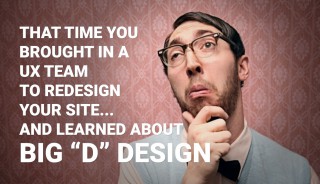What's the Big D?
Our broad portfolio of clients and industries has exposed us to a diverse array of UX problems. A good deal of the work lives in the box people refer to as UI / Interaction Design (workflow, layout, visual design, content strategy, branding, etc.). There is, however, a whole other category of “issues” that you might not traditionally call “UX”. We see this come up from time to time and call it, “the Big D”.
There are a lot of themes we can discuss here, but general idea is to re-organize operations to sustainably support the customer/user/constituent experience. These issues fall primarily into the following categories:
- Training
- Business Process Re-engineering
- Systems Integration & Infrastructure Enhancement
- Change Management
There are other more closely related UX themes at play here too. If you haven’t watched Dr. Susan Weinschenk’s video on the ROI of UX it will help fill in the gaps.

How do you know if you have Big D issues?
Many organizations – mostly enterprise scale and federal government agencies -have grown their operations to handle digital content and service delivery organically. While it might not exactly have happened like this, you can imagine the evolution occurred over many painstaking decisions, through a series of big contracts by various vendors all pushing their wares or by whatever leadership or CRM training flavor of the month resonated the most. The effect is basically not seeing the forrest for the trees.
For the fortunate businesses / organizations with healthy leadership, there are known issues and plans in place to re-invigorate and revitalize the digital experience. But in our experience, while these plans exist they are typically generated top down without full awareness of the downstream impacts (internal and external to the organization)… that’s usually where a team like ours comes in.
It might be, that your product/service is experiencing user acceptance issues, usability problems, or a general decline customer satisfaction. That’s when you start looking for a UX shop to help understand why and to build a design plan to get back on track. If the project scoping includes stakeholder interviews and user research this is where you’ll get the opportunity to learn if you have BIG D problems.
Unfortunately in today’s fast paced race to sprint and continuously integrate just to keep up with the pack, most organizations see stakeholder workshops and user research as unnecessary costs that they can handle in-house.
If the UX shop offers user research, and you feel like this is an “unnecessary or unaffordable cost”, you’ve lost your shot at discovering your Big D problems.
How Does UX = Big D Awesome?
A thorough UX project scope will typically include stakeholder workshops/interviews along with product walkthrough and an overview of known user experience/usability pain points. These are generally proposed to better understand internal processes and operations geared to capture and handle digital presence, your product, customer communications and services.
While the primary focus is “How can we increase user satisfaction and UX design awesomeness?” we invariably discover a percentage of the problems in the user experience are systemic and require organizational changes.
- Training: While not often admitted, this is typically a bigger problem than organizations know – usually on a given technology: think salesforce, sharepoint, and other customer support frameworks
- Centralization/Communication/Collaboration – organizational silos typically lead to redundant and often-inconsistent work. This hurts you internally, but also shows your customers a state of disorganization.
- Business Process and Infrastructure – we often find a lack of technology to support of business process management and where there are gaps in digital processes, human errors tend to cause failure. Where the systems are in place, they’re not configured optimally to harness their full yield to your organization.
- Change Management – this one is usually a bitter pill. It’s hard to admit when your team hasn’t re-organized or hired the right skills mix to meet the needs that fully support today’s digital consumer. Without getting into politically charged conversations your UX consultant will tactfully identify the gaps and provide you with the right list of skills to seek out. In the best case scenario, you have the skills in house – it just requires some change.
If the internal review and analysis are coupled with user research focused on internal / external users, a UX shop can underpin all of the issues above as experienced by the most important folks… your users.
Beyond UX
If the project was a success, you launch your revitalized or new product/feature with the team in place to capture, analyze, design and support user satisfaction in a sustainable and evolutionary state of being.
Afterword: UX, as a practice, has often been situated as a nexus point for business, technical and marketing within in-house product teams as well as large systems integration and management consultancies. There’ve been many debates on the role of UX, where does it fit/belong exactly? In truth, while there are specialists (UX leads, user researchers, usability specialists, ui and interaction designers, front end developers) – the role of UX is a shared responsibility.
Whether you’re a CEO, business analyst, engineer… you have to constantly challenge yourself to contextualize what you’re doing from the view of the end user. Not just the things you’re directly working on, but how it impacts their perception of the company brand at large.
In the end, one tiny flaw in a product can cause irreparable damage in the users perception of your brand or product – so it’s worth it to step back… and discover your own Big D.
Learn more about Limina to see if we can help you discover your Big D!